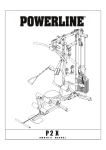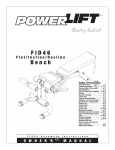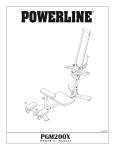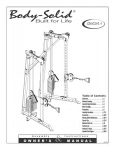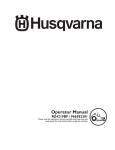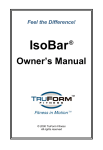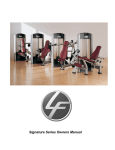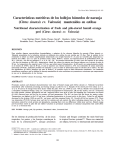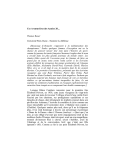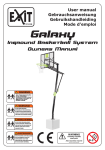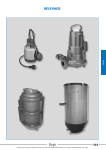Download Body Solid GDKR50 Owner`s manual
Transcript
® by GDKR50 ® by by Table of Contents ® A s s e m b l y O W N E R ’ S & Important Safety Instructions. . . . . . . . . . . p. 2 Before You Begin. . . . . . . . . . . . . . . . . . . . . . p. 3 Preparations. . . . . . . . . . . . . . . . . . . . . . . . . . p. 4 Assembly Instructions. . . . . . . . . . . . . . . . . p. 5-9 Exercise Tips. . . . . . . . . . . . . . . . . . . . . . . . . p. 10-29 Mainframe Parts List. . . . . . . . . . . . . . . . . . . p. 30 Hardware List. . . . . . . . . . . . . . . . . . . . . . . . . p. 30 Exploded View Diagram. . . . . . . . . . . . . . . . p. 31 I n s t r u c t i o n s M A N U A L v. 042310 I m p o r t a n t S a fe t y I n s t r u c t i o n s Before beginning any fitness program, you should obtain a complete physical examination from your physician. Il est conseille de subir un examen medical complet avant d’entreprendre tout programme d’exercise. Si vous avez des etourdissements ou des faiblesses, arretez les exercices immediatement. Antes de comenzar cualquier programma de ejercicios, deberias tener un examen fisico con su doctor. When using exercise equipment, you should always take basic precautions, including the following: The GDKR50 is designed for your enjoyment. By following these precautions and using common sense, you will have many safe and pleasurable hours of healthful exercise with your Body-Solid GDKR50. m Read all instructions before using the GDKR50. These instructions are written to ensure your safety and to protect the unit. After assembly, you should check all functions to ensure correct operation. If you experience problems, first recheck the assembly instructions to locate any possible errors made during assembly. If you are unable to correct the problem, call the dealer from whom you purchased the machine or call 1-800-556-3113 for the dealer nearest you. m Do not allow children on or near the equipment. m Use the equipment only for its intended purpose as described in this guide. Do not use accessory attachments that are not recommended by the manufacturer. Such attachments might cause injuries. m Wear proper exercise clothing and shoes for your workout, no loose clothing. Obtaining Service m Use care when getting on or off the unit. Please use this Owner’s Manual to make sure that all parts have been included in your shipment. When ordering parts, you must use the part number and description from this Owner’s Manual. Use only Body-Solid replacement parts when servicing this machine. Failure to do so will void your warranty and could result in personal injury. m Do not overexert yourself or work to exhaustion. m If you feel any pain or abnormal symptoms, stop your workout immediately and consult your physician. m Never operate the unit when it has been dropped or damaged. Return the equipment to a service center for examination and repair. For information about product operation or service, check out the official Body-Solid website at www.bodysolid.com or contact an authorized Body-Solid dealer or a Body-Solid factory-authorized service company or contact Body-Solid customer service at one of the following: m Never drop or insert objects into any opening in the equipment. m Always check the unit and its cables before each use. Make sure that all fasteners and cables are secure and in good working condition. Toll Free: Phone: Fax: Hours: E-Mail: m Do not use the equipment outdoors or near water. Personal Safety During Assembly 1-800-556-3113 1-708-427-3555 1-708-427-3556 M-F 8:30-5:00 CST [email protected] Or write to: m It is strongly recommended that a qualified dealer assemble the equipment. Assistance is required. m Before beginning assembly, please take the time to read the instructions thoroughly. Body-Solid, Inc. Service Department 1900 S. Des Plaines Ave. Forest Park, IL 60130 USA Retain this Owner’s Manual for future reference. Part numbers are required when ordering replacement parts. m Read each step in the assembly instructions and follow the steps in sequence. Do not skip ahead. If you skip ahead, you may learn later that you have to disassemble components and that you may have damaged the equipment. m Assemble and operate the GDKR50 on a solid, level surface. Locate the unit a few feet from the walls or furniture to provide easy access. 2 B e fo r e Yo u B e g i n Thank you for purchasing the GDKR50! To maximize your use of the equipment please study this Owner’s Manual thoroughly. Unpacking the Equipment Be careful to assemble all components in the sequence presented in this guide. The GDKR50 is carefully tested and inspected before shipment. Body-Solid ships the unit in several pieces that require assembly. Ask for assistance during the assembly process. If any items are missing, contact the dealer from whom you purchased the unit or call 1-800-556-3113 for the dealer nearest you. Carefully unpack the box and lay the pieces on the floor near the area where you plan to use the equipment. Body-Solid continually seeks ways to improve the performance, specifications and product manuals in order to ensure that only superior products are released from our factories. Please take the time to carefully read through this manual thoroughly. Instructions contained in this document are not intended to cover all details or variations possible with Body-Solid equipment, or to cover every contingency that may be met in conjunction with installation, operation, maintenance or troubleshooting of the equipment. Even though we have prepared this manual with extreme care, neither the publisher nor the author can accept responsibility for any errors in, or omission from, the information given. Should additional information be required, or should situations arise that are not covered by this manual, the matter should be directed to your local Body-Solid representative, or the Service Department at Body-Solid Inc. in Forest Park, Illinois. Any Questions? Call (800) 556-3113 3 P r e p a r at i o n s CAUTION: To set up this unit, you will need assistance. Do not attempt assembly by yourself. You must review and follow the instructions in this Owner’s Manual. If you do not assemble and use the GDKR50 according to these guidelines, you could void the Body-Solid warranty. Required Tools CAUTION: Obtain assistance! Do not attempt to The basic tools that you must obtain before assembling the GDKR50 include but are not limited to: m Adjustable Wrench m Rubber Mallet m Silicone Spray Oil assemble the GDKR50 by yourself. Review the Installation Requirements before proceeding with the following steps. The GDKR50 unit comes in one box. Be careful to assemble components in the sequence presented in this guide. Installation Requirements Follow these installation requirements when assembling the GDKR50: Set up the GDKR50 on a solid, flat surface. A smooth, flat surface under the machine helps keep it level. A level machine has fewer malfunctions. Provide ample space around the machine. Open space around the machine allows for easier access. Fill out and mail the warranty card. 4 A s s e m b l y I n s t r u c t i o n s Assembly of the GDKR50 takes professional installers about 1/2 hour to complete. If this is the first time you have assembled this type of equipment, plan on significantly more time. Professional installers are highly recommended! However, if you acquire the appropriate tools, obtain assistance, and follow the assembly steps sequentially, the process will take time, but is fairly easy. Assembly Tips IMPORTANT! Read all “Notes” on each page before beginning each step. Before you begin you should look at the quick reference guide that shows all hardware parts (in actual size) along with the corresponding key numbers on the assembly instructions. While you may be able to assemble the GDKR50 using the illustrations only, important safety notes and other tips are included in the text. Some pieces may have extra holes that you will not use. Use only those holes indicated in the instructions and illustrations. NOTE: To find out the length of a particular bolt, measure its shank (the long, narrow part beneath the head). Refer to the following diagram: Do not fully tighten bolts until instructed to do so. Note: After assembly, you should check all functions to ensure correct operation. If you experience problems, first recheck the assembly instructions to locate any possible errors made during assembly. If you are unable to correct the problem, call the dealer from whom you purchased the machine or call 1-800-556-3113 for the dealer nearest you. 5 STEP 1 Be careful to assemble all components in the sequence they are presented. A. Connect Left Support Frame (C) and Right Support Frame (B) to Main Frame (A) using: Two 1 (M10x102 hex head bolt) Four 3 (M10 curved washer) Two 5 (M10 nylon nut) 6 STEP 1 Above shows Step 1 assembled and completed. 7 STEP 2 Be careful to assemble all components in the sequence they are presented. A. Connect Rack (D) to Main Frame (A) using: Two 2 (M8x58 hex head bolt) Two 4 (M8 washer) Two 6 (M8 nylon nut) B. Congratulations!! You have completed the assembly of the GDKR50. 8 STEP 2 Above shows Step 2 assembled and completed. 9 PHRASES, TERMS, TIPS & GUIDELINES B E G I N N E R ’ S G U I D E L I N E S • Work out at least two times a week. • Include six to eight exercises that train major muscle groups. • Perform two or three sets of at least eight to 12 repetitions. AEROBIC EXERCISE LARGE MUSCLES FIRST ANAEROBIC EXERCISE PROGRAM DURATION ATROPHY GIVE YOUR MUSCLES A REST Exercise that primarily uses oxygen to burn fuel at low to moderate levels of intensity. Running and jogging are examples of aerobic exercise. Exercise that primarily uses the body’s stored fuel for energy. Intense weightlifting is an example of an anaerobic exercise. Decrease of a muscle caused by the decrease in the size of its cells because of inactivity. You should work your large muscle groups first (ie. squat, bench press, lat pulldown) before you exercise your small muscle groups (ie. bicep curls, tricep pressdowns, lateral raises). A weight training routine should take anywhere from 45 minutes to one hour to complete. Add another 20 to 60 minutes when you include stretching, warm-up, aerobics and cool-down. You’ll get the most out of strength training if you give your muscles at least 48 hours rest to recover and rebuild between strength training workouts. BALLISTIC STRETCHING A stretching technique that involves a bouncing or bobbing movement during the stretch. The final position is not held. This is not a recommended stretching technique. BREATHING Never hold your breath during any part of an exercise. Holding your breath may cause severe intra-thoracic pressure and raise blood pressure leading to dizziness, blackout or other complications. The rule of thumb is to exhale on exertion and inhale on the return part of the exercise. CARDIOVASCULAR Referring to the heart, lungs, and other periphery systems involved in the transport of oxygen throughout the body. CHALLENGE YOUR MUSCLES All strength training should progress gradually, using increases in weight until your goals are reached. Then, change your workout to include increased reps or a higher weight resistance. Alter the order of your exercises, perform multiple sets or different exercises to maintain results or reach new goals. CHANGE ROUTINE HYPERTROPHY Enlargement of a muscle caused by an increase in the size of its cells in response to weight training. INTENSITY The degree to which the body is worked during exercise. ISOKINETIC EXERCISE Resistance is given at a fixed velocity of movement with accommodating intensity. A machine that moves you through an entire range of motion at a preset speed and will not change no matter how much pressure is put forth by the individual. ISOMETRIC EXERCISE Contracts the muscle statically without changing its length. Example: Attempting to lift a weight heavier than you can handle, but cannot move. ISOTONIC EXERCISE Shortens and lengthens the muscle through a complete range of motion. This defines weight training with full range of motion. Beginner’s please note: If you want to make changes in the exercise routine that you do, wait until about the six to eight week point. Advanced lifters may want to change routines to avoid plateus in gaining size or strength. MUSCLE FATIGUE CIRCUIT TRAINING The ability to perform repetitive muscular contractions against some resistance. Exercise stations that consist of various combinations of weight training, flexibility, calisthenics, and aerobic exercise. CONCENTRIC MUSCLE ACTION Fatigue is when you can’t possibly do another rep without sacrificing form. MUSCULAR ENDURANCE MUSCULAR STRENGTH The maximum force that can be applied by a muscle during a single maximum contraction. OSTEOPOROSIS The muscle shortens while contracting against resistance. A decrease in bone density. ECCENTRIC MUSCLE ACTION PLYOMETRIC EXERCISE The muscle lengthens while contracting against resistance. EXERCISE FREQUENCY Exercise each muscle group 2-3 times per week. Allow a minimum of 48 hours rest for each muscle group worked. If you are doing a total-body workout, three training sessions per week, performed on every second day, is adequate. 44 10 A technique that includes specific exercises which encompass a rapid stretch of a muscle eccentrically, followed immediately by a rapid concentric contraction of that muscle for the purpose of facilitating and developing a forceful explosive movement over a short period of time. Examples of these are using medicine balls for upper extremity and depth jumping for lower extremeity. PHRASES, TERMS, TIPS & GUIDELINES S T A R T I N G R E S I S T A N C E L E V E L If you begin weight training at too high a level, you risk serious injury. You will also develop poor form, which will hinder your efforts and discourage you. Use this as a guideline: if you cannot lift the weight eight times with proper form, the weight is too heavy. Similarly, don’t choose too light a weight; the last two or three repetitions of your set should be difficult. POWER REST INTERVAL Power is the rate of performing work. Power during a repetition is defined as the weight lifted times the vertical distance the weight is lifted divided by the time to complete the repetition. Power during a repetition can be increased by lifting the same weight the same vertical distance in a shorter period of time. Power can also be increased by lifting a heavier resistance the same vertical distance in the same period of time as a lighter resistance. Allow a brief pause between sets to give your muscles a chance to partially recover before working them again. For power and muscle size development allow a 3 to 4 minute rest interval between sets. For muscular endurance and definition allow a 30 second rest interval. For strength training allow a 60 to 90 second rest interval. RISK SHOULD NOT EXCEED BENEFIT PROGRESS GRADUALLY Increase reps before increasing resistance. Reduce rest intervals between sets to increase intensity. If the risk of a specific exercise exceeds its potential benefit, it is best to stay on the conservative side. There are several ways to work specific muscle groups. Choose those that provide minimal risk. Ask a fitness professional for guidance. PROGRESSIVE RESISTANCE ROUTINE The principle of continually adding more weight to a specific exercise as your muscles become stronger to adapt to the heavier weights. The specific exercises, sets, reps and weight for a specific body part. SET PROPER FORM This is a group of repetitions performed continuously without stopping. While a set can be made up of any number of repetitions, sets typically range from 1 to 15 repetitions. Focus on the proper motion of the exercise and concentrate on the specific muscles being used. Do not sacrifice proper form to lift heavier weight or to perform more repetitions. Proper form also means lifting in a smooth, fluid motion. If you feel strain elsewhere, you should re-evaluate the amount of weight you are lifting or have a qualified professional critique your exercise motion. SMALL MUSCLE GROUP EXERCISE Single joint movement and isolation exercises (i.e. bicep curls, tricep pressdowns and leg extensions). PROPER POSTURE SPEED OF MOVEMENT Maintaining proper posture will greatly reduce chances of injury and maximize exercise benefit. When standing always keep your feet shoulder-width apart. Do not lock your knees. Locking your knees can put unnecessary strain on them. Keep your back flat and straight, making sure not to twist or arch it in order to complete a repetition. Strength training movements should be slow and controlled. Do not use momentum to complete an exercise movement. Momentum puts unnecessary stress on tendons, ligaments and joints. Using momentum in your exercise movements does not develop increased strength. STATIC STRETCHING PROPER TECHNIQUE A stretching technique that involves holding a specific muscle or muscle group at a desired length for a certain period of time. This type of stretching is highly recommended. To get the most out of strength training and to reduce the chance of injury, use proper weight training techniques. These include working your muscles through their full range of motion (but not locking any joints), lifting at a speed at which you can control the weight and stop easily if necessary. STOP TRAINING IF YOU FEEL PAIN If you feel pain during a specific exercise stop immediately. Any continuation may aggravate an existing injury. Re-evaluate your routine to make sure that you are doing a proper warm up. Decrease the amount of weight you are lifting. Talk to a qualified personal trainer, health professional or your doctor. RANGE OF MOTION Moving through a complete range of motion (ROM) allows the muscles to stretch before contraction and increases the number of muscle fibers being recruited. This produces maximum contraction and force. By working the full ROM, flexibility will be maintained and possibly increased. STRENGTH Strength is the maximal amount of force a muscle or muscle group can generate in a specified movement pattern at a specified velocity of movement. REPETITION WARM UP A repetition is one complete movement of an exercise. It normally consists of two phases: the concentric muscle action, or lifting of the resistance, and the eccentric muscle action, or lowering of the resistance. This cannot be stressed enough. Many workout-related injuries can be avoided by a proper warm up routine. Try to do a total body warm up before you start training. A good example of a total body warm up is using a stationary bike, treadmill, elliptical, rowing or skiing machine. It is especially important to warm up specific muscle groups you are going to be using. Your muscles need a 5 to 15 minute warm up as well as a brief cool down. This can be as simple as performing a warm up set of high repetitions and light weight (25% to 50% of your training weight) for each exercise. REPETITION MAXIMUM (RM) This is the maximum number of repetitions per set that can be performed at a given resistance with proper lifting technique. Thus, a set at a certain RM implies the set is performed to momentary voluntary fatigue. 1RM is the heaviest resistance that can be used for one compete repetition of an exercise. 10 RM is a lighter resistance that allows completion of 10 (but not 11) repetitions with proper exercise technique. WORKOUT The routine, specific exercises, weights, sets, and reps for one or more body parts. 11 45 NUTRITION Good nutrition is a diet in which foods are eaten in proper quantities and with the needed distribution of nutrients to maintain good health. Malnutrition, on the other hand, is the result of a diet in which there is an underconsumption, overconsumption, or unbalanced consumption of nutrients that leads to disease or an increased susceptibility to disease. What is stated in the above definitions is the fact that proper nutrition is essential to good health. A history of poor nutritional choices will eventually lead to poor health consequences. There are many substances necessary for the proper functioning of the body. Nutrients are the substances that the body requires for the maintenance of health, growth, and to repair tissues. Nutrients can be divided into six classes: carbohydrates, fats, proteins, vitamins, minerals and water. Carbohydrates, or "carbs", are nutrients that are composed of carbon, hydrogen and oxygen, and are essential sources of energy in the body. Grains, vegetables, and fruits are excellent sources of carbohydrates. It is recommended that at least 55% to 60% of the total number of calories consumed come from carbohydrates (American Diabetes Association, Diabetes & Exercise, 1990). It is further recommended that 10% or less of the total calories consumed come from simple sugars like a candy bar. One of the many benefits of consuming foods that are high in complex carbohydrates, such as rice, pasta, and whole grain breads, is that they also typically contain dietary fiber. Dietary fiber is a term used when referring to substances found in plants that cannot be broken down by the human digestive system. Although fiber cannot be digested, it is important in helping to avoid cancers of the digestive system, hemorrhoids, constipation, and diverticular disease because it helps food move quickly and easily through the digestive system. It is recommended that people consume 20 to 30 grams of fiber per day (American Diabetes Association, Diabetes & Exercise, 1990). Excellent sources of dietary fiber are grains, vegetables, legumes, and fruit. directly related to increased cardiovascular disease. Unsaturated fats are typically liquid at room temperature. Corn, peanut, canola, and soybean oil are sources of unsaturated fats. It is recommended that no more than 30% of one’s diet be composed of fats. Ten percent or less of the total calories consumed should come from saturated fats. One way to reduce saturated fat intake would be to substitute margarine for butter. Proteins are substances composed of carbon, hydrogen, oxygen, and nitrogen. Proteins are made by combining amino acids. Amino acids are nitrogen-containing building blocks for proteins that can be used for energy. Amino acids can combine in innumerable ways to form proteins, and it is estimated that tens of thousands of different types of proteins exist in the body. It is the ordering of the amino acids that provides the unique structure and function of proteins. There are proteins in both meat products and plant products. Animal sources of protein such as milk, meat and eggs contain the eight essential amino acids (amino acids that the body cannot synthesize and therefore must be ingested). Plant sources of protein such as beans, starchy vegetables, nuts, and grains do not always contain all eight amino acids. Because of this, vegetarians must consume a variety of protein-containing foods. It is recommended that proteins make up 10% to 15% of one’s daily calories. This will ensure adequate protein for growth, maintenance, and the repair of cells. Protein requirements for adults are not as high as those recommended for infants, children, and young adults. Note: individuals who are training intensely will have an increase in their protein requirements. a decrease in the total amount of bone mineral in the body and by a decrease in strength of the remaining bone. This condition is most common in the elderly but may also exist in younger people who have diets inadequate in calcium or vitamin D or both. Iron is another mineral that is often underconsumed by Americans. This is especially true of women. The oxygen-carrying properties of hemoglobin (blood) depend on the presence of iron. Anemia is a condition characterized by a decreased capacity to transport oxygen in the blood, and is also common in those lacking a sufficient amount of iron intake. Red meat and eggs are excellent sources of iron. Additionally spinach, lima and navy beans, and prune juice are excellent vegetarian sources of iron. Sodium, on the other hand, is a mineral that many Americans over-consume. High sodium intake has been linked with hypertension, as well as high blood pressure. People can substantially reduce their sodium intake by limiting consumption of processed foods and decreasing the amount of salt added to foods when cooking. In conclusion...don’t forget hydration. Water is considered an essential nutrient because of its vital role in the normal functioning of the body. Water contributes approximately 60% of the total body weight and is essential in creating an environment in which all metabolic processes occur. Water is necessary to regulate temperature and to transport substances throughout the body. Vitamins are organic substances that are essential to the normal functioning of the human body. Although vitamins do not contain energy to be used by the body, these substances are essential in the metabolism of fats, carbohydrates and proteins. Because of the critical role vitamins play, it is necessary that they exist in proper quantities in the body. 1. Fats are an essential part of a healthy diet and serve vital functions in the human body. Among the functions performed by fats are temperature regulation, protection of vital organs, distribution of some vitamins, energy production, and formation of component parts of cell membranes. Like carbohydrates, fats are composed of carbon, hydrogen, and oxygen. However, their chemical structure is different. Minerals are inorganic molecules that serve a variety of functions in the human body. The minerals that appear in the largest quantities (calcium, phosphorus, potassium, sulfur, sodium, chloride, and magnesium) are often called macrominerals. Other minerals are also essential to normal functioning of the body, but because they exist in smaller quantities (chromium, iron, copper, fluoride, iodine, manganese, molybdenum, selenium, and zinc) they are called microminerals. 4. Both animals and plants provide sources of fat. Saturated fats come primarily from animal sources and are typically solid at room temperature. Plant sources of saturated fats are palm oil, coconut oil, and cocoa butter. A high intake of saturated fats is A mineral that is often consumed in inadequate amounts by Americans is calcium. Calcium is a mineral important in the mineralization of bone, muscle contraction, and the transmission of nerve impulses. Osteoporosis is a disease characterized by 12 46 2. 3. 5. 6. 7. FOLLOW THESE BASIC NUTRITIONAL GUIDELINES FOR GAINS IN STRENGTH AND LEAN MUSCLE MASS: Choose your foods carefully. Try getting your carbohydrates from sources such as rice, vegetables, beans, whole grains, pasta and fruit. Good protein sources include fish, chicken, turkey, lean meat and low-fat or nonfat dairy products. Minimize your fat intake. Drink a minimum of 10 eight-ounce glasses of water each day. Eat four to six small meals a day, about three hours apart. Small meals are more easily digested and result in greater nutrition absorption. Avoid eating junk food and fast food. Time your protein intake of 40-55 grams approximately 75 minutes after your workout. Immediately following your workout, replenish your glycogen stores with approximately 50-75 grams of carbohydrates. For more information on nutrition visit your local library or book store. There are many excellent books available. EXERCISE PRESCRIPTION Sets Sets are defined as a combination of any number of reps of one exercise. The number of sets used in a workout is directly related to training results. Typically, two to three sets are used by intermediate and advanced lifters to achieve optimum gains in strength. Experts agree that multiple-set systems work best for the development of strength and muscular endurance. Gains will be made at a faster rate by using a multiple-set system than gains achieved through a single-set system. The use of a single set of an exercise is recommended and very effective for individuals who are untrained or just beginning a resistance training program. One-set programs might also be used for simple maintenance once you are in shape. It is important to note that low-volume set programs will increase strength in untrained individuals, but more complex physiological adaptations, such as gains in muscle mass, tone, size, and performance usually requires higher-volume set training for the best results. Multiple sets of an exercise present a more intense training stimulus to the muscles during each set. Once your desired initial fitness level has been achieved, multiple-set performances of the exercise using the proper resistance (with specific rest periods between sets) will take you to the next level of strength training, endurance, and muscular development. Rest Periods Between Workouts The amount of rest between training sessions depends on the recovery ability of the individual. Most experts agree that three workouts per week with one day of rest between sessions allows adequate recovery, especially for the beginner. If the resistance training is not excessive, only moderate amounts of delayed muscular soreness should be experienced one day after the session. As the lifter advances and his or her body is better able to tolerate and recuperate from the resistance exercise sessions, the frequency of training can be increased. Well-conditioned athletes may be capable of, and need training frequencies of 4 to 5 days in a row to improve significantly and achieve their desired goals. When consecutive-training-day sequences are used, it is usually beneficial to do different exercises for the same muscle groups and use different resistances for the exercises. When training is performed on consecutive days, it often involves the use of a split routine (different body parts exercised each day), or a split program (different exercises for the same body part performed each day). There are many books available at the library or your local book store for the intermediate and advanced weight training enthusiast. It is also recommended that you work with a qualified personal trainer to achieve your ultimate goals. Resistance Used The amount of resistance used for a specific exercise is probably the most important variable in resistance training. When designing a resistance training program, a weight for each exercise must be chosen. The use of repetition maximums (RM): the exact resistance that allows only a specific number of repetitions to be performed, is probably the easiest method for determining a resistance. Typically, one uses a training RM target or a RM target zone. Example: If your RM zone is 8 to 12 repetitions and you cannot lift the weight at least 8 times using proper form, the weight is too heavy. On the other hand, if you can easily lift the weight 12 times, the weight is too light. In either case, the weight needs to be changed. As the strength level of the lifter changes over time, the resistance is adjusted so a true RM target or target zone resistance is used. Order of Exercise Leaders in the field of strength and conditioning believe that working the larger muscle groups first (chest, back, legs), should take priority over training the smaller muscle groups (biceps, triceps, deltoids, calves). The reason behind this exercise order is that the exercises performed in the beginning of the workout are the ones that are going to require the greatest amount of muscle mass to perform. Hence, exercising the smaller muscle groups first will deplete the body of the energy necessary to stimulate the larger muscle groups. Arm-to-leg ordering allows for some recovery of the arm muscles while the leg muscles are exercised. “Stacking” exercises is a common practice among body builders as a way to attempt to bring about muscle hypertrophy. Stacking is loading up different exercises on the same muscle group (ie. standing bicep curls, preacher curls, one arm concentration curls). The exercise order will have a significant impact on the training stimulus stress level in a training session. Rest Periods Between Sets and Exercises One frequently overlooked variable in exercise prescription is the length of the rest period between sets and between different exercises. Your desired fitness goals will normally determine the amount of time you allow your body to rest. Exercises involving high repetitions (15 to 20) and a high number of sets (3 to 4) with short rest periods (30 seconds) between sets will raise metabolic demands. This in turn will burn excess body fat and increase muscular endurance. Short rest periods are a characteristic of circuit weight training, and the resistances used are typically lighter. This type of workout is best for trimming body fat and toning muscle. Exercises with heavier resistance and fewer sets usually have a longer resting period between sets. The results of using this method are normally increased muscular strength and mass. If the desired outcome is to gain overall muscle mass, your exercise prescription should lean toward a higher weight resistance doing 2 to 6 repetitions per set, with a rest period of 3 to 4 minutes between each set. 13 47 Scheduling Training Finding the time to do it is one of the most difficult aspects of a training program. Once you have established a time to workout you should plan a training routine based on what muscles to involve on which day. As previously discussed, the larger muscle groups such as the chest, back, and legs should take priority over working the smaller muscle groups. Give your muscles at least 48 hours (but no more than 72 hours) of rest in between sessions. TRAINING TIPS FOR BEGINNER’S A R E Y O U A “ B E G I N N E R ” ? A beginner can be classified as someone who has never touched a weight, may have lifted for a while, but has taken a substantial amount of time off, or has not consistently trained over the last six months. If you happen to fall into any of these categories, pay close attention, because the following information will be detrimental to the start of your training program. As a beginner, one of the most common mistakes is doing too much. Because beginners often make good gains quickly, many fall into the trap of thinking that more is better. This may be true later in the training equation, but not for the novice. Some of the most common injuries occur as a result of taking on too much, too soon. One of the questions most frequently asked is, “How much weight should I use?” Determining the weight for each exercise will vary from person to person. The weight for each exercise will be lifted in sets and repetitions. Repetition is defined as one execution of any exercise. A set is a combination of any number of repetitions of one exercise. Experimentation at each exercise station is a good technique for determining the starting weight for an individual. Take the chest press exercise for example. Performing this exercise with a weight that can be pressed 30 times with ease will not help you achieve any particular goals. Adding the appropriate amount of weight that will allow you to perform a maximum of 8 to 12 repetitions will help you obtain the results you desire. On the other hand, if you put too much weight on the press bar and press it 4 or 5 times, then common sense will tell you to reduce the weight, wait a few minutes, then try again. Remember, never sacrifice perfect form just for the sake of lifting heavier weight. This is a sure-fire, one-way trip down the road to injury. Making muscles work hard, with proper form is the name of the game. Now that you understand how to test each station for your starting amount of resistance, you should know which muscles to train first. Training the large muscles groups first, such as your chest, legs, and back, should be done before training your small muscle groups like the arms, shoulders, and calves. You need to give your body plenty of rest, especially if you’re still sore from the last workout. This will keep you fresh and growing stronger. NEVER TRAIN A BODY PART THAT IS STILL SORE FROM THE PREVIOUS WORKOUT. Performing some flexibility exercises is a good way to keep the blood flowing through the sore area, but do not train these muscles again until you are feeling recovered. Speaking of soreness, there is something else that you, as a beginner, should be aware of: If you work out - your muscles will get sore. The majority of muscle soreness comes from microtears and a build up of lactic acid in the muscle fibers. This is the result of intense exercise. Muscle soreness can become a problem when the body is pushed too fast and too quickly. As a beginner, tendons, ligaments, joints and tissues have not yet developed the ability necessary to recover from high intensity exercise. A general warm up of stretching and light calisthenics prior to exercise can possibly reduce the amount of post-exercise muscle soreness. A good cool down of stretching and cardio work may also decrease muscle soreness. Now that we have laid a good foundation of the “do’s and don’ts”, let’s get into something a little more specific. The Beginner’s Strength Training Program. One of the best beginner’s programs is the three-days-a-week routine. For example, do a whole-body workout on Monday, Wednesday and Friday. Use the other days for rest and recuperation. As previously discussed, you want to start with the large muscle groups first, then move on to the small muscle groups. Perform one exercise per muscle group that consists of 2 or 3 sets of 8 to 12 repetitions. Follow this routine for at least six to eight weeks in order for your body to establish the proper stimulation for growth. Starting with the large muscle groups will help you achieve and maintain quicker gains. The large muscles groups will require more stimulation and a higher intensity level than the smaller muscle groups. Training your arms with all-out intensity and training your chest immediately afterwards will not leave you with enough energy necessary to properly stimulate the muscle fibers in your chest. Moreover, because the triceps are required in chest press movements, your arm muscles will fail much more quickly than your chest muscles, which will also hold back your chest training. As a beginner, you will find that your gains will come quickly. The excitement and enthusiasm that comes with these gains may cause you to spend even more time on your gym. Take it easy! Remember, just as too little exercise won’t stimulate muscle growth...too much exercise won’t either. One or two exercises per muscle group may not sound like enough to produce any results, but if you’re a beginer - it most definitelty will. As you conitinue to train and your body adapts to your exercise routine and recuperative demands you place upon it, you’ll be able to add more sets and exercises to your routine. Another point that is highly recommended is the assistance of a personal trainer. Through the use of a personal trainer you can learn the mechanics and techniques of exercise, how to use proper form to avoid injury and details on proper nutrition. A good trainer will also provide MOTIVATION. When choosing a personal trainer, here are some tips: Choose an individual that is certified through an accredited association. This is a good way to ensure that he or she is qualified to give you what you need. Also, take a look at what kind of shape they are in. If you want to be in great shape, look for a trainer who is in great shape. They will know what it takes to get results. Here are a few recommended organizations: • National Strength & Conditioning (719) 632-6722 • American College of Sports Medicine (317) 637-9200 • National Academy of Sports Medicine (312) 929-5101 SAMPLE WORKOUT ROUTINE WHEN TRAINING FOR STRENGTH Exercises Reps Sets Leg Press / Squat Leg Extension Leg Curl Calf Raise Bench / Chest Press Incline Press Incline Pec Fly Lat Pulldown Seated Row Military Press Upright Row Bicep Curl Tricep Pressdown Tricep Extension Resistance Ab Crunch Resistance Oblique Crunch 8 to 12 8 to 12 8 to 12 8 to 12 8 to 12 8 to 12 8 to 12 8 to 12 8 to 12 8 to 12 8 to 12 8 to 12 8 to 12 8 to 12 20 to 30 20 to 30 2 or 3 2 or 3 2 or 3 2 or 3 2 or 3 2 or 3 2 or 3 2 or 3 2 or 3 2 or 3 2 or 3 2 or 3 2 or 3 2 or 3 2 or 3 2 or 3 Rest period between sets should be about 60 to 90 seconds. 14 48 COMMON TRAINING MISTAKES 1. Lack of Adequate Warm-Up and Inadequate Flexibility A warmed muscle is a more flexible muscle that’s better able to lift heavier weights and work in a full range of motion. Those warmed muscles also greatly reduce your chance of training injuries. 2. Improper Form The use of improper form is a good way to keep you out of the gym. Not only does improper form cause injuries, it also doesn’t allow for adequate muscle-fiber stimulation. 3. Too Much Weight Overloading the muscles is a good way to promote muscular growth, but packing on too much weight can cause a snowball effect of improper form, injuries, and down time from your routine. 4. Not Enough Weight Not lifting enough weight will prohibit the stimulation necessary for muscular growth. Keep challenging yourself to lift heavier weights on a progressive basis always maintaining proper form. 5. Not Enough Rest Between Workouts If you’re still sore from your previous workout, you don’t have to go back at it just because it’s your scheduled day. Give your body an extra day off to fully recover so when you return you will be able to give 100%. 6. Overtraining It’s not how much time you spend working out, but what you accomplish that really matters. Try to keep your resistance workouts within 45 to 60 minutes per session. 7. Poor Diet and Supplementation Eating the right combination of foods, along with good supplementation, will greatly promote your success. Make your diet 50 percent carbohydrate, 35 percent protein, 15 percent fat, and take a good multivitamin and protein / carbohydrate supplement. Don’t forget the water- at least 80 ounces a day! Hydration is critical. 8. Stale Routines Your body adapts very quickly to the demands placed upon it. That’s why you should have a variety of exercises and routines that you can do. To keep your body growing, you’ve got to keep it off-guard. Changing your exercises and routines is a sure way to do it. 49 15 SETTING UP YOUR PERSONAL PROGRAM It is important to first establish specific and realistic goals. You should determine your long term goal and then set a series of short term goals that will help you attain your long term goal. The most common goals are: Muscular Endruance & Definition Increase Strength Increase Power & Muscle Mass Once you have determined your personal goals, you will need to set up a schedule that helps you attain them. Set up a schedule that includes the number of workouts per week, the type of workout activity, the time of day for each workout, and the actual workout program. Don’t forget to factor in the warm up and cool down periods. You may have to modify your current lifestyle to accommodate your new schedule. It’s very important to include the following basic components to achieve successful results: If your personal goals involve losing a considerable amount of body fat you will need to focus more on aerobic exercise and weight training for muscular endurance and definition. If your goals involve a large increase in muscle size you will need to focus on power and muscle mass weight training. Depending on your goals, you will have different nutritional requirements. 16 50 Stretching Aerobic Exercise Weight Training Nutrition DETERMINE YOUR TRAINING METHOD There are three basic types of weight training methods: Which training method is right for you? 1. Training for muscular endurance and definition 2. Training for strength 3. Training for power and muscle mass FOR MUSCULAR ENDURANCE & DEFINITION You should select a training method that reflects both your present fitness level and your long term goals. You should begin carefully and with proper professional guidance. You can always move from one training method to another as you progress. If you are beginner, you should start slowly and carefully, gradually increasing the frequency and intensity of your training. Always play it safe – be realistic about your goals and your schedule. Realistic goals are safer and easier to follow. Which is the right training method for you? First, take a look at your present physique and determine your objectives. Do you want a trim, toned, well-defined body? Are you involved in a sport where speed, strength and power are most important? Maybe you want bulging muscles and a terrific V-shape torso so you look great on the beach. Once you make a decision on what the final results should be, you can set up your personal program using the proper training method to achieve your goals. This training method incorporates achieving and maintaining a high cardiovascular (heart) rate and helps burn away excess fatty tissue. It also adds muscle definition and muscular endurance to your entire body. Exercises are most commonly performed for 15 to 20 repetitions and 3 to 4 sets using a light to moderate weight. The rest period between sets should be about 30 seconds. These short rest intervals will help maintain an elevated heart rate and prevent the muscles from cooling down. FOR STRENGTH This type of training is the most popular of the three and is designed specifically for increasing strength throughout the muscle and the muscle-tendon junction. This type of training is especially important for athletes. Normally, exercises are performed using moderate to heavy weight for 8 to 12 repetitions and 2 to 3 sets. The rest period between sets should be from 60 to 90 seconds. This allows a degree of muscle recovery before you hit them again. FOR POWER AND MUSCLE MASS This is the method most often used by bodybuilders and is recommended only for the intermediate and advanced lifter. The weights used are heavy — this shocks the muscles and stimulates a more rapid increase in muscle size. Usually exercises are performed for 2 to 6 repetitions and 3 to 4 sets using very heavy weight. The rest period between sets should be from 3 to 4 minutes. The prolonged rest periods allow ample time for recovery between sets. DESIGNING YOUR PERSONAL ROUTINE FIRST: You need to decide which of the above training methods is best suited to accomplish your personal goals. SECOND: Study the exercise poster that came with your Body-Solid machine and select one or two exercises per body part (body parts are listed to the left of the exercise pictures). Be sure to include exercises for all body parts. If you leave out certain body parts your exercise routine and your body will not be balanced. If you are trying to increase muscle mass or increase strength to a muscle group it is alright to add extra exercises to the area you are particularly concerned about. THIRD: Coordinate your body part exercise program and your personal schedule. If you select one exercise per body part you can normally do your entire routine in the same workout. If you choose to do more than 12 exercises you may decide to divide your workout routine into upper and lower body exercises. You can split your schedule to work upper body one day and lower body the next day. Remember to rest each particular muscle group 48 hours before working it again. 17 51 FOURTH: Order the exercises in your routine so you are working the large muscle groups first and the small muscle groups last. FIFTH: Keep a record! Write down the exercises, number of sets, number of reps and the amount of resistance (weight). BEGINNER’S SAMPLE WORKOUT ROUTINE WHEN TRAINING FOR DEFINITION Exercise Bench / Chest Press Lat Pulldown Shoulder Press Tricep Pressdown Bicep Curl Leg Press/Squat Leg Extension Leg Curl Calf Raise Reps 15 to 20 15 to 20 15 to 20 15 to 20 15 to 20 15 to 20 15 to 20 15 to 20 15 to 20 Sets 3 or 4 3 or 4 3 or 4 3 or 4 3 or 4 3 or 4 3 or 4 3 or 4 3 or 4 EXERCISETIPS Listed below are Body-Solid’s picks of the best exercises you can do for each body part. These exercises can be done using free weights, machines and multi-station gyms. Learn to do each exercise in proper form. You can make substitutions in your training and try variations of each using different Body-Solid grips, cable attachments and accessories to slightly change the emphasis of a particular exercise. Note: Many movements, especially multijoint exercises, work more than one muscle group. For example, your front deltoids and triceps are stimulated during bench / chest pressing movements. CHEST This powerful muscle group is the cornerstone of a well-developed upper body. To most thoroughly work your pecs, include both pressing and fly movements and vary the angle of the bench from decline to flat to incline. BENCH / CHEST PRESS INCLINE PRESS DECLINE PRESS PEC FLY INCLINE FLY DECLINE FLY CABLE CROSSOVER DIPS SHOULDERS The shoulder joint, which has the greatest range of motion of all joints in the body, is best worked by training all three deltoid heads. Include a pressing movement followed by a raise for each of the three heads. SHOULDER PRESS BEHIND THE NECK PRESS FRONT DELTOID RAISE LATERAL (SIDE) DELTOID RAISE BENT-OVER LATERAL DELTOID RAISE REVERSE PEC-FLY UPPER BACK A powerful upper back is marked by both middle-back thickness and width (the sought-after V-taper). This is best achieved by combining various rows with pull-downs and pull-ups. Remember to vary your grip to slightly change the stimulus. PULL UP UPRIGHT ROW LAT PULLDOWN SEATED ROW BENT OVER ROW HIGH ROW REVERSE GRIP PULLDOWN TRAPS BICEPS / FOREARMS A signature muscle of a strong upper back, well-developed traps help prevent neck injury. Shrug movements should be done with heavy weights in a straight up-and-down motion. A two-headed muscle, the biceps’ primary focus is to flex your elbow and supinate your wrist. The ability to build your biceps peak is largely genetic, but exercises that maximally stress the short head will help. STRAIGHT BAR SHRUG DUMBBELL SHRUG BEHIND THE BACK SHRUG UPRIGHT ROW BICEPS STANDING BICEP CURL SEATED BICEP CURL INCLINE CURL PREACHER CURL CONCENTRATION CURL ONE-ARM CABLE CURL FOREARMS WRIST CURL REVERSE WRIST CURL LOWER BACK Important not only for spinal protection but also because it’s the seat of power for many exercises. If you spend a great deal of time crunching for abs, you need to balance your training for complete development and muscular balance. ABDOMINALS PULL UP UPRIGHT ROW LAT PULLDOWN SEATED ROW BENT OVER ROW HIGH ROW REVERSE GRIP PULLDOWN The rectus abdominus has upper and lower regions, but you can’t isolate one area over the other. Still, include both upper and lower ab movement to more strongly emphasize those areas, and do twisting movements to work the obliques for complete development. UPPER AB REGION CABLE AB CRUNCH DECLINE BENCH CRUNCH LOWER AB REGION REVERSE CRUNCH HANGING KNEE RAISE HIP THRUST OBLIQUES CABLE SIDE BEND OBLIQUE CRUNCH TRICEPS This three-headed muscle on the back of your arm is involved in extension of the elbow. Like the biceps, the triceps cross the elbow and shoulder joints. Because of this, you can and should work the triceps through a variety of angles to ensure complete development. LYING TRICEPS EXTENSION CABLE TRICEPS EXTENSION CABLE TRICEPS PRESSDOWN CLOSE-GRIP BENCH PRESS REVERSE-GRIP PRESSDOWN TRICEPS PRESS DIPS THIGHS / GLUTES The main muscles of the thighs are the quadriceps which are composed of four muscles. You have several others near the hip joint, including the body’s largest muscle group, the gluteals. Multijoint movements (in which action occurs at both the hip and knee joints) are your best choice to work these muscles. BACK SQUAT FRONT SQUAT LEG PRESS LUNGE REVERSE LUNGE STEP-UP LEG EXTENSION (does not work glutes) HAMSTRINGS On the back of the thighs, the hamstrings balance the quads and allow for a wide range of movement. Good exercise choices include those that work the hamstrings and both the hip and knee joints. DEADLIFT STIFF-LEGGED DEADLIFT GOOD MORNING LYING LEG CURL SEATED LEG CURL ONE-LEGGED STANDING LEG CURL CALVES Calves consist of two major muscles, the gastrocnemius and soleus. The latter is best worked when the knee is flexed, as in the seated calf raise. STANDING CALF RAISE SEATED CALF RAISE DONKEY CALF RAISE LEG PRESS CALF RAISE HACK SQUAT CALF RAISE 18 52 ANATOMY CHART FRONT VIEW Note: These illustrations depicting exaggerated musculature are not in the textbook anatomical position. As such, they are inexact for medical purposes but are useful for a general understanding. Chest Neck Omohyoid Sternohyoid Sternocleidomastoid Trapezius Pectoralis Major Pectoralis Minor (beneath major) • • • • • • • • • • Abs Serratus Anterior External Oblique Rectus Abdominis Tendinous Inscriptions • • • • • Pollicis Brevis • Extensor Pollicis Longus • • • • • • Tensor Fasciae Latae Abductor Pollicis Longus Flexor Carpi Radialis Brachioradialis • Vastus Medialis Sartorius Pectineus Adductor Longus Gracilis Deltoid anterior head middle head posterior head • Flexor Carpi Ulnaris Calves Gastrocnemius Soleus • • • • Trapezius Erector Spinae (deep) Semitendinosus Gracilis Semimembranosus 19 53 • • • • Iliotibial Band Biceps Femoris Adductor Magnus Tibialis Anterior Triceps Brachii lateral head longhead Rhomboid Major Hamstrings Peroneus Longus Extensor Digitorum Longus Triceps Infraspinatus Thoracolumbar Fascia • Tibia (bone) Teres Minor Teres Major Latissimus Dorsi Vastus Lateralis Rectus Femoris Patella (kneecap) BACK VIEW Back • • • Biceps Brachialis Biceps Brachii Pronator • head • long Teres short head • • Palmaris • • Forearms • Longus •• Extensor Carpi Ulnaris Extensor • Thighs Shoulders • • • • medial head • • Abs External Oblique • • • Glutes • • • • Gluteus Medius Gluteas Maximus • • • • Calves Gastrocnemius Soleus Peroneus Brevis Flexor Hallucis Longus 20 Make several copies of this page to keep track of your progress. You can print more copies of this page by going to http://www.bodysolid.com/support/docs.html 21 Make several copies of this page to keep track of your progress. You can print more copies of this page by going to http://www.bodysolid.com/support/docs.html 22 Make several copies of this page to keep track of your progress. You can print more copies of this page by going to http://www.bodysolid.com/support/docs.html 23 STRETCHING & FLEXIBILITY Flexibility is an important component of physical fitness and needs to be addressed in a resistance training program. The two main purposes for stretching are injury prevention and a faster rate of recovery from exercise. Stretching should be performed in both the warm up and cool down phases of a training session. A good general guideline is that each workout session should be preceded by 5 to 15 minutes of general warm up, followed by 8 to 12 minutes of stretching, and concluded with 4 to 5 minutes of post-exercise stretching. The following pages show illustrations with descriptions of static stretching for warm up and post-exercise cool down. Remember... stretch your large muscle groups first and do all stretches in a smooth, slow, controlled manner. A regular stretching program will loosen muscle tissue, allowing an increased range of motion. This helps prevent microtears at the muscle-tendon junction. Almost 90% of all injuries from muscle strain occur at the muscle-tendon junction. Repeated injury at this junction can lead to a build-up of scar tissue, which impedes range of motion and adds stress to the joints. Begin by stretching the major muscle groups first. Move in and out of your stretches with smooth, slow, controlled motion. Hold the stretch for at least 10 seconds when you feel you have reached your muscle’s maximum distance. Do not use fast, hurried or reckless motions when stretching. Fast and bouncy motions will increase the risk of injury. The most common and most popular type of stretching is the static stretching technique. This form of stretching involves voluntary, complete relaxation of the muscles while they are elongated. A static stretch is a constant, steady stretch in which the end position is held for 10 to 30 seconds. This technique is popular because it is easy to learn, effective, and accompanied by minimal soreness with the least risk of injury. Ballistic stretching involves a bouncing or bobbing movement during the stretch. The final position in the movement is not held. Ballistic stretching is unpopular because of the increased amount of delayed muscle soreness and the possibility of injury during the stretching exercise. Ballistic stretching is not recommended. A dynamic stretch involves flexibility during sport specific movements. Dynamic stretching is similar to ballistic stretching in that it utilizes movement, but dynamic stretching includes movements that may be specific to a sport or movement pattern. Dynamic stretching is most common among track and field athletes, but is also used in other sports, such as basketball and volleyball. An example of dynamic stretching would be a track sprinter performing high knees with an emphasis on knee height and arm action, not on horizontal speed. 24 STRETCHING UPPER BACK WARM-UP/COOL-DOWN Cross Arm in Front of Chest MUSCLE(S) AFFECTED: latissimus dorsi and teres major 1. Stand or sit with the right arm slightly flexed (15° to 30°) and adducted across the chest. 2. Grasp the upper arm just above the elbow, placing the left hand on the posterior side of the upper arm. 3. Pull the right arm across the chest (toward the left) with the left hand. 4. Hold for 10 seconds. 5. Repeat with the left arm. Stretching the upper back UPPER BACK Arms Straight Up Above Head (Pillar) Stretching the shoulders, chest and upper back MUSCLE(S) AFFECTED: latissimus dorsi and wrist flexors 1. Stand with arms in front of torso, fingers interlocked with palms facing each other. 2. Slowly straighten the arms above the head with palms up. 3. Continue to reach upward with hands and arms. 4. While continuing to reach upward, slowly reach slightly backward. 5. Hold for 10 seconds. LOWER BACK Stretching the low back and sides Spinal Twist (Pretzel) MUSCLE(S) AFFECTED: internal oblique, external oblique and spinal erectors 1. Sitting with legs straight and upper body nearly vertical, place right foot on left side of left knee. 2. Place back of left elbow on right side of right knee, which is now bent. 3. Place right palm on floor 12 to 16 inches behind hips. 4. Push right knee to the left with left elbow while turning shoulders and head to the right as far as possible. Try to look behind the back. 5. Hold for 10 seconds. 6. Repeat with left leg. LOWER BACK Stretching the low back from seated position Semi-Leg Straddle MUSCLE(S) AFFECTED: spinal erectors 1. Sitting, knees flexed 30 to 50 degrees, let the legs totally relax. 2. Point the knees outward; the lateral side of the knees may or may not touch the floor. 3. Lean forward from waist and reach forward with extended arms. Hold position for 10 to 15 seconds. 4. Bending and relaxing legs decreases hamstring involvement and increases lower back stretch. 25 59 STRETCHING WARM-UP/COOL-DOWN SIDES Side Bend with Straight Arms MUSCLE(S) AFFECTED: external oblique, latissimus dorsi and serratus anterior 1. 2. 3. 4. Stand with feet 14 to 16 inches apart. Interlace the fingers with palms facing each other. Reach upward with straight arms. Keeping arms straight, lean from waist to left side. Do not bend knees. 5. After moving as far as possible, hold for 10 seconds. 6. Repeat to the left side. Stretching the sides, upper back and shoulders SHOULDER Stretching shoulder joints—sitting Seated Lean-Back MUSCLE(S) AFFECTED: deltoids and pectoralis major 1. Sitting with legs straight and arms extended, place palms on floor about 12 inches behind hips. 2. Point fingers away (backward) from body. 3. Slide hands backward and lean backward. 4. Hold for 10 seconds. CHEST Stretching the chest Straight Arms Behind Back MUSCLE(S) AFFECTED: deltoids and pectoralis major 1. 2. 3. 4. 5. 6. Standing, place both arms behind back. Interlock fingers with palms facing each other. Straighten arms fully. Slowly raise the straight arms. Hold for 10 to 15 seconds. Keep head upright and neck relaxed. Remember... do all stretches in a smooth, slow, controlled manner. 26 60 STRETCHING WARM-UP/COOL-DOWN Stretching the hamstrings with emphasis on insertion of the hamstrings and calves. POSTERIOR OF THIGH Sitting Toe Touch MUSCLE(S) AFFECTED: hamstrings, spinal erectors and gastrocnemius 1. Sit with the upper body nearly vertical and legs straight. 2. Lean forward from waist and grasp toes with each hand, slightly pull toes towards the upper body, and pull chest towards leg. (If you are very stiff, try to grasp the ankles.) Hold for 10 seconds. 3. Release toes and relax foot. 4. Grasp ankles and continue to pull chest towards legs. Hold for 10 seconds. 5. Still grasping the ankles, point away from body and continue to pull chest towards legs. Hold for 10 seconds. Stretching the hamstrings with emphasis on the middle portion. Stretching the hamstrings with emphasis on the upper portion. GROIN Stretching the groin Butterfly MUSCLE(S) AFFECTED: adductors and sartorius 1. Sitting with the upper body nearly vertical and legs straight, flex both knees as the soles of the feet come together. 2. Pull feet toward body. 3. Place hands on feet and elbows on legs. 4. Pull torso slightly forward as elbows push legs down. 5. Hold for 10 to 15 seconds. 27 61 STRETCHING WARM-UP/COOL-DOWN GROIN Straddle (Spread Eagle) MUSCLE(S) AFFECTED: gastrocnemius, hamstrings, spinal erectors, adductors and sartorius 1. Sit with the upper body nearly vertical and legs straight, and spread legs as far as possible. 2. With right hand, grasp toes of right foot and pull on toes slightly, while pulling chest toward right leg. Hold for 10 seconds. 3. Release toes and relax foot. 4. Grasp ankle and continue to pull chest toward right leg. Hold for 10 seconds. 5. Point toes away from body and continue to pull chest toward right leg. Hold for 10 seconds. 6. Repeat process with the left leg. 7. Repeat process by grasping right toes with right hand and left toes with left hand. Move the torso forward and toward the ground. Stretching the hamstrings and groin with emphasis on insertion of the hamstrings and calves Stretching the hamstrings and groin with emphasis on the upper portion Stretching the groin, low back and hamstrings 28 62 STRETCHING WARM-UP/COOL-DOWN POSTERIOR OF LOWER LEG Step Stretch MUSCLE(S) AFFECTED: gastrocnemius and soleus; also, achilles tendon 1. 2. 3. 4. 5. Have ready a step or board 3 to 4 inches high. Place balls of both feet on the step or board, 1 inch from its edge. With straight legs, lower heels as far as posible. Hold for 10 to 15 seconds. To stretch achilles tendon, raise heels slightly. Slightly flex the knees and then lower the heels. This stretch will be felt in the achilles tendon. 6. Hold for 10 to 15 seconds. 7. For a more intense and individualized stretch, perform this stretch with one leg at a time. Stretching the calves standing on a step Preparing to stretch the achilles tendon by slightly bending the knee 63 29 Stretching the achilles tendon by lowering the heel M a i n f r a m e Part# A B C D Qty Pa r t s Description 1 1 1 1 Main Frame Right Support Frame Left Support Frame Rack H a r d wa r e 1 2 3 4 5 6 L i s t 2 2 4 2 2 6 L i s t Hex Head Bolt Hex Head Bolt Curved Washer Washer Nylon Nut Pad Part numbers are required when ordering parts. 30 M10x102 M8x58 Ø10 Ø8 M10 41mm x 46mm x ᵟ 4mm E x ploded V iew D ia g ram GDKR50 31 45 ® 1900 S. Des Plaines Ave. Forest Park, Il 60130 1 (800)by556-3113 Hours: M-F 8:30 - 5:00 www.bodysolid.com 2010. Body-Solid. All rights reserved. Body-Solid reserves the right to change design and specifications when we feel it will improve the product. c Copyright Body-Solid machines maintain several patented and patent pending features and designs. All rights reserved on all design patents and utility patents.
































